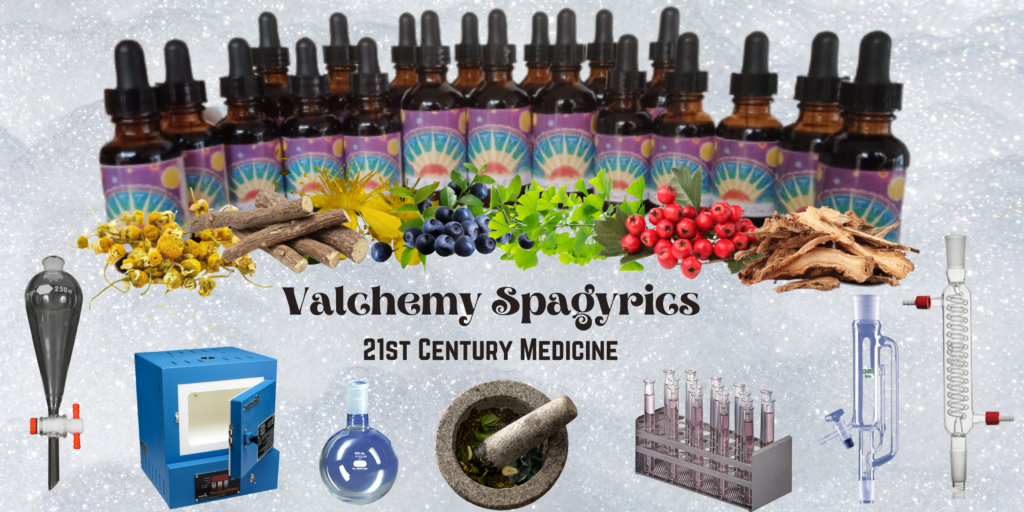Episode 8 – Spagyrics: 21st Century Medicine
ello friends and welcome to the Holistic Health Online Podcast. I’m your host, Val Robitaille. And in this episode, I’d like to tell you about the herbal medicine that I make here in Morocco. So after giving you a brief explanation of what I call Valchemy, 21st Century Medicine, I’ll go over a few herbs that I consider foundational for good immunity and overall good health.
I make a unique kind of medicine using a process called Spagyrics. The word and the method was established by Paracelsus, who was a renaissance man of the 15th and 16th centuries. There are some interesting and wild stories about him on the Internet, but no one discounts the powerful medicine that he created. I assume there were means of slandering, suppression and censorship back then, as there is today, so I’m only going to judge him by his good works and what he did for humanity.
A spagyric remedy is an alchemical preparation of plants that separates the three elements, or categories, that make up the plant according to plant alchemy verbiage. The sulfur, which is considered the soul of the plant, the mercury considered the spirit, and the salt or the body.
In ancient texts, the word spagyric actually means to separate and recombine. And in my work, this translates to plant alchemy. Minerals can be spagyrically crafted as well, and there are herbalists that make animal spagyrics, too. But I think that’s kind of rare, and I don’t know much about it. Even though I live in the desert I’m not motivated to catch scorpions for the work I do, no matter how good their venom may be.
Now, I understand that alchemy has gotten a bad rap in the media in the past century or so but let’s take a step back and try to go to the root of the method. What I’m actually doing when I practice plant alchemy is I’m extracting the medicinal elements, purifying them and putting them back together which results in a highly concentrated medicine. But maybe concentrated isn’t the right word because all the original ingredients are there, plus the additional alcohol. But they do create a more potent medicine than a conventional tincture. This is because they are almost instantly absorbed into the cells of the body, and this is because the constituents of the herbs are almost identical to the constituents of the cells in chemical composition and electrical charge.
Spagyric remedies are a type of very sophisticated and elegant natural medicine. I’ve been learning and doing this work for over a period of 25 years, the first 20 being in the study alone. (You can see my humble beginnings in the lab 4 years ago HERE) Basically, what I’m doing in the lab these days is I’m working with the plant material that I’ve either grown in my garden or have imported from different areas all over the world in the case of rare plants that I might need that I can’t seem to grow here in this very dry climate.
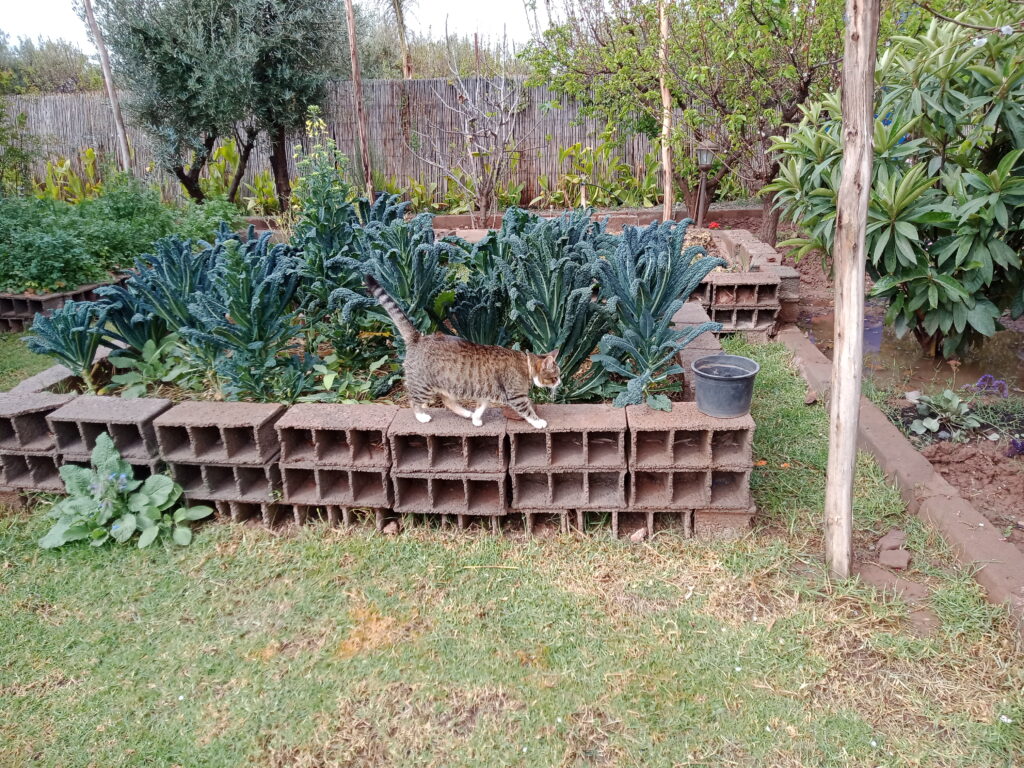
Tarzan and the kale
Aziz washing the burdock

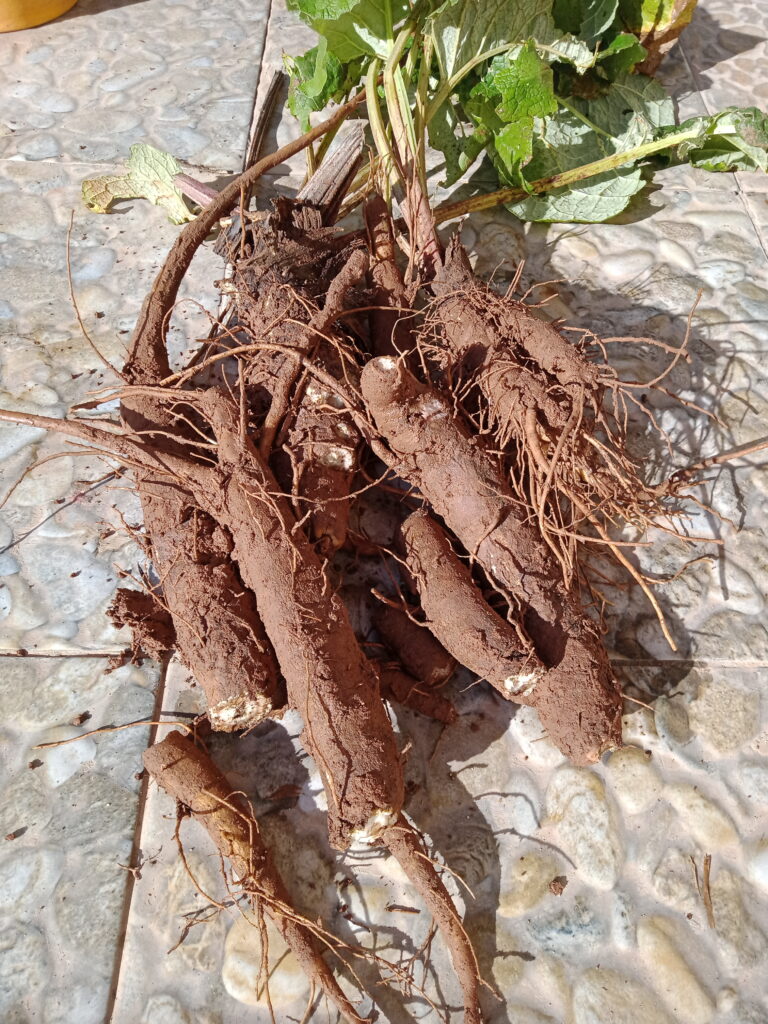
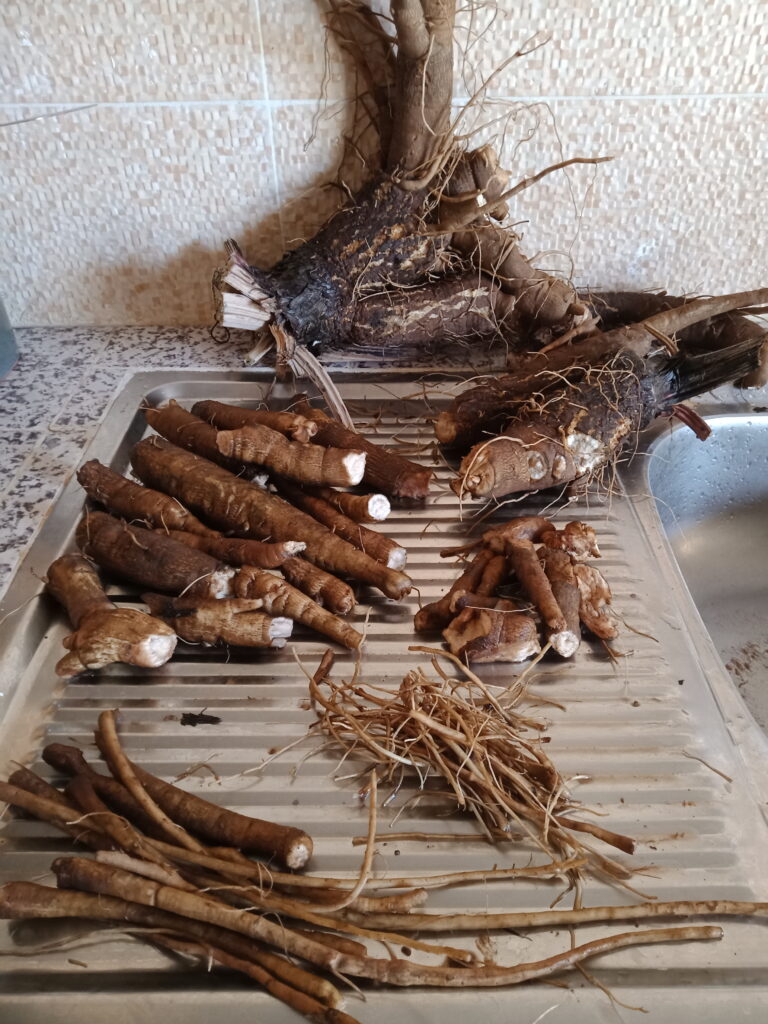

The beginnings of the work in Morocco – 2019
Process
I soak the herbs in alcohol in the form of vodka for six weeks or longer. Once that period of time has passed, I’m able to strain the material which I save, and I have a pure tincture of that plant that is extracted and in the alcohol. Then I take the plant material and put it into a crucible and put the crucible into a kiln at 1200 degrees F for, well…so it goes like this: The first burn, which we call calcination in spagyrics, I usually keep it in
for about 40 to 60 minutes. I let it cool down, I open the kiln, I grind up the herb, which is now looking like charcoal, and I put it back in the kiln for another, um depending on the difficulty of getting to the ash, which is what I’m ultimately looking to get – some plants are more difficult than others to get to that point. We’re looking for as close to a white ash as we can get. So it always takes more than one burn. And each time you take the ashes out of the kiln, you grind it and put it back as many times as you feel you need to to see if you can get to that nice white ash. Some plants just won’t get there but as close as you can get.
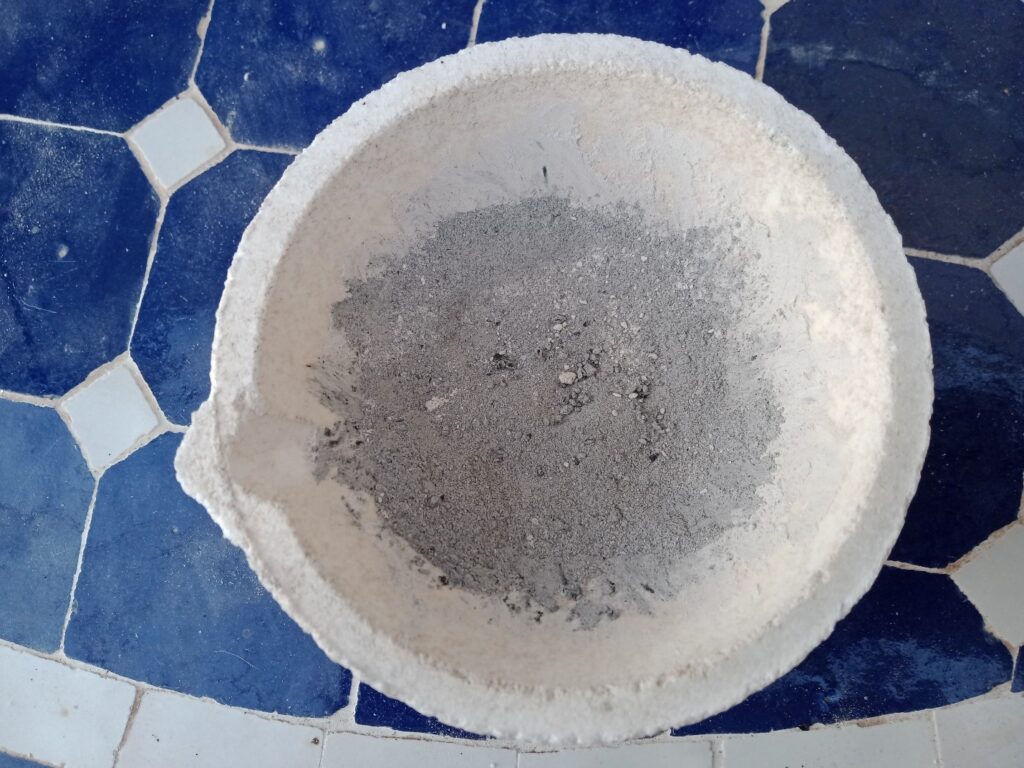
Calcination – This must go back in the kiln until it is a fine ash
As you can see, this is a very time consuming process because it takes at least 15 to 20 minutes until you can open the kiln door with protective gloves and other equipment. You let it cool down a little bit, open the door a little bit more. It takes about 45 minutes until you can take your crucible out of the kiln to be able to grind it. I would say each herb that I’m working with takes a minimum of 5 hours to calcine completely, and some have taken all day.
After the ash has cooled, I put it back into the tincture and I set it back up on the shelf for about another week or longer, and then I strain it one final time and I have a pure spagyric medicine. What makes it pure and spagyric is that I have literally opened up the plant and accessed the three main principles – which I should mention are philosophical principles or things to think about as you’re doing the work, not their standard. elemental definitions. For example, mercury has nothing to do with the element mercury on the periodic table except for the fact that it has an attribute of being slippery and elusive, representing the spirit of the plant that is now in the alcohol.
The sulfur or soul of the plant is in the essential oils that are in the plant material left behind after straining the tinctures. And the salts, the ashes which represent the body of the plant, are full of minerals that have been purified and ready to be absorbed into our cells. And because this medicine is more pure and potent than a conventional tincture, we need to take less. And I think the dosage is about half. So if on a bottle of tincture, you see take 30 drops, you would take 15 drops of a spagyric tincture.
When I first came to the area that I’m now living in in Morocco, I set up my lab and I was blessed to have six apricot trees in my backyard. Everything was just dirt and there were just these six apricot trees and two huge olive trees, a fig tree, a mango tree, and that was it in the yard. But for me it was enough and it was a great blessing because I have always wanted to make medicine and some of the medicine that I want to make is vitamin B 17, also known as Laetrile which is illegal in the United States. So here I am in Africa and I have six apricot trees from which to collect the kernels and make the medicine.
I can only assume that it’s illegal in the United States because it’s a potent anti carcinogen. So one of my first batches of medicine that I’ve made here was a batch of B 17 and it’s just lovely. I have been taking it for many months, not because I have cancer but because I know that it’s a foundational health habit of many countries in the world that have trees, that have stone fruits like apricots, peaches, plums. These all have vitamin B 17.
Regardless of what you see on Google and hear in the mainstream media, Laetrile kills cancer cells through a chemical reaction that releases just a minute bit of cyanide, which is not poisonous to the body but kills cancer. Of course, the powers that be have done everything that they can to prevent this information from getting out to the public. They have arrested people that have been trying to provide this to those who want it, and it’s gotten bad press when you watch mainstream media, I’ve been taking the batch for quite a while now that I made, and I have a couple more batches brewing that should be ready sometime before summer. I’m still alive and they can’t get me here because what I’m doing is perfectly legal.
The next plant that I would like to talk about is star anise, which you may have heard is very important in these times of spike protein transmission between the vaccinated and the unvaccinated, the spike protein aspect of the SARS-CoV-2 virus, and the spike proteins that are being replicated in those who have taken the COVID vaccination.
Star anise contains a metabolic derivative called shikimate. This metabolite has an inhibitory effect on the infamous spike protein.
An important point to make over and over again is that SARS-CoV-2 is the industry’s name for the virus that was synthetically manufactured in a lab and allowed to escape and infect humans. There are different doctors and health researchers that do not believe there is a virus, only a reaction to a poison. I am among these but to keep things simple for this podcast I’ll just stick with the term virus. But it’s not what we humans have come to know as a natural virus, such as smallpox or measles. Sars-cov-2 virus, along with the spike protein it contains, were created in a lab and specifically designed to do great damage to the human body, particularly in areas with high amounts of receptors that are targeted by the spike protein so that it can get into the cell’s nucleus and begin to replicate more spike protein.
The body rightfully sees this as an attack as the spike proteins are being manufactured, and responds with an army of immune cells known as a cytokine storm, which can be deadly if there aren’t enough antioxidants present in the body.
Incidentally, in next week’s podcast, I’ll be speaking with Hope Girl over at hopegirlblog.com about the history of this covid war, and we’ll be getting into more detail about the ongoing spike protein problem.
So SARS-CoV-2 is the virus and COVID is the disease caused by this virus, and the spike protein is the poison. Spike proteins are what create the problems in those who get the COVID disease, and they are what the mRNA so-called vaccines contain, which when people are inoculated, encourages the body to make more spike proteins.
Star anise is a vital ingredient in Chinese and Arab medicine. It’s widely used for its antiviral effects, which is the reason it’s used in the antiviral pharmaceutical drug Tamiflu given to people with the flu. Star anise contains the highest amount of shikimate found in food types but there are other foods and spices that contain shikimate such as fennel, Schisandra, St John’s Wort, Ginkgo Biloba and of course, you’ve probably heard about pine needles.
Shikimate controls platelet aggregation or blood clotting, and there’s even a biological process known as the Shikimate pathway but I won’t go into that here. It’s good stuff and needs to be considered by everyone interested in stopping the spike protein from damaging your cells.
Star anise and fennel are easily accessible where I live in Morocco and of course I take full advantage of this fact. I have not hesitated to continue to put up batches of tinctures of star anise, fennel, etc., and my family takes it whenever we have to go to be among crowds or people that we know have been jabbed because we did tend to feel quite ill after certain events and so many people had been recently vaccinated. We tend to stay away from crowds as much as we can now but when we do go out we make sure to take at least ten drops of star anise tincture.
Our co-star is Dandelion, which belongs to the Sunflower family and is an incredibly healing plant that’s been used for thousands of years in China, and at least centuries in traditional medicine practices all over the world.
Dandelion purifies the blood, works in the liver and the kidneys, and strengthens the immune system. Dandelion is rich in vitamins A, B, C and D, and has essential fatty acids and antioxidants, and aids in digestion by increasing the release of stomach acid and bile.
One of the aspects of the SARS-CoV-2 virus is its ability, or I should say it’s design to bind to the ACE2 receptors on kidney and lung cells where it causes the most common damage that we’ve heard about. But I believe that these receptors are on other cells as well. The point is that dandelion has been shown to prevent this binding to the receptors so the spike protein does not get into the cell to replicate.
Dandelion, along with burdock roots, are what is known as alteratives, meaning, herbs that gradually restore the proper function of the body systemically, and generally increase health and vitality.

Dandelion Leaf
CLICK HERE
Burdock root is known as a blood purifier and like dandelion, it has tonic properties. When you hear the word tonic or toning when talking about herbal medicine, what that medicine is doing is restoring normal tone to muscles or other organs.
Burdock also contains vitamins and minerals, antioxidants and something called Inulin, which is a prebiotic. A prebiotic is something that helps your intestines make good, healthy intestinal flora.
And burdock treats conditions that are caused by an overload of toxins. It has what we call a mucilaginous effect in the gut, which makes bowel movements much easier and much more effective in removing foreign invaders.
So not only do I have two huge and very old beautiful olive trees in my backyard, I happen to live in an olive grove and have plenty of access to olive leaves from which I make spagyric tinctures. Olive Leaf has a list of benefits a mile long and I’m blessed to have this at my fingertips. It treats gastrointestinal disorders like constipation and diarrhea, dysentery treats ulcers, hemorrhoids, gastritis, peptic ulcer, colitis, irritable bowel syndrome, etc.
Olive leaf has polyphenols, the main one is known as oleuropein. This substance improves the absorption of nutrients from food and prevents bacterial overgrowth. Olive leaf is another herb that increases the secretion of bile acids that helps with digestion, and has also been shown to strengthen mucosal barriers, which is what we’re looking for; to make sure that the muscles, organs, tissues and all the cells are being toned and have good membrane impermeability to foreign substances.
Olive leaf naturally lowers blood pressure and prevents cardiovascular disease, and has been used and well known as an antiviral, antibacterial and antifungal herb for many years, and throughout many generations.
What I have learned about herbs over the years is that there are overlapping properties for health. For example, you can look for something that’s antiviral and find many herbs. This is because plants are made up of constituents and they make chemical reactions in the body, in the cells and in circulation. So although we can’t find every herb in every country, countries have herbs that have certain constituents that keep those people healthy.
If you don’t have an olive tree or an apricot tree in your backyard, perhaps you have burdock and dandelion weeds. Or maybe, you know, someone that makes tinctures, or your favorite health food store is stocked with nice tinctures and extracts. In my opinion and in my practice, I find botanical medicines, the herb kingdom, to be far superior to pharmaceutical drugs that are very dangerous and damage, sometimes permanently, organs, tissues and cells.
I hope you’ll join me next week when Hope Girl and I will be discussing all aspects of COVID, including vaccines and the political issues and responses to this nefarious disease, or rather, bioweapon.
To see more about Valchemy and Spagyrics go HERE
